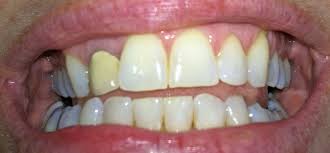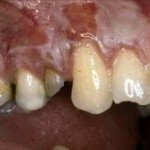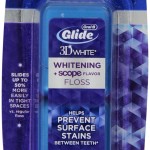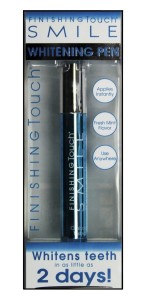Cosmetic Dentistry Advisor highly recommends teeth whitening if you are not happy with the shade and general appearance of your teeth. It is one of the easiest, least invasive and most cost effective ways of improving your smile. People are increasingly concerned about the appearance of their teeth and a sparkling white smile has become very fashionable.

Teeth Whitening
It is possible to whiten a specific tooth or all of your teeth. This can be done in the dentist’s office, in the comfort of your own home or a combination of both. Natural teeth whitening are also quite popular as you can whiten your teeth without buying very expensive bleaching agents, although you should be very careful not to damage your teeth. Whitening toothpaste is a very convenient way to keep your smile bright without costing a fortune.
Teeth Whitening often plays an important part of a comprehensive cosmetic dentistry treatment plan. The teeth can be whitened before veneers, crowns, implants and bridges are done for a great, white aesthetic result.
Before Whitening your Teeth
Visit your dentist for a thorough examination. Tooth decay, chips and fractures should be treated. Ask your dentist about your tooth whitening options and discuss the pros and cons before making a decision. Your dentist or oral hygienist should clean your teeth very thoroughly in order to remove any plaque, tartar and superficial staining before you bleach your teeth. You should also make sure that you have a good oral hygiene regime in place. Use a good quality electric toothbrush, preferably a sonic toothbrush. Floss daily and use a suitable toothpaste and mouthwash. Tooth sensitivity should be addressed first as the tooth bleaching agents (usually Carbamide Peroxide or Hydrogen Peroxide) can cause even more sensitivity. Your dentist may advise the use of products such as GC Tooth Mousse before, during and after bleaching in order to limit sensitivity and improve the strength of your teeth. Research your teeth whitening options and the cost involved, to ensure that you use the option that suits you best.
Advantages of Teeth Whitening
- Greatly improve the color and brightness of your teeth.
- A single discolored tooth can be bleached to match the other teeth. A tooth can discolor if it is non-vital, typically after an abscess and rootcanal treatment. The bleaching agent can be placed inside the tooth, on the outer surface or both.
- Improve self confidence.
- Easy and non-invasive. No drilling, local anesthetic or impressions required.
- In comparison to veneers and crowns, tooth whitening is a very affordable option.
- You can bleach your teeth in the comfort of your own home or wherever you are. You also have control over when and for how long you want to bleach your teeth, in order to fit it in to your daily schedule.
- Many options to suit your needs. Your teeth can be bleached in the dentist’s office within an hour if you are in a hurry to get your white smile, or slowly over an extended period at home. You can pick an expensive whitening system, or start with an affordable over-the-counter kit. You may even decide on a more natural approach like using coconut oil.
- Teeth whitening can be done in conjunction with other cosmetic dentistry procedures, in order to get the best, cosmetic result.
Disadvantages and risks of Teeth Whitening
- Existing restorations such as fillings, veneers and crowns do not bleach and may need replacement if they do not match whitened teeth anymore.

Crown Darker than the other Teeth
- Rebound of whitened teeth. This may happen after a quick, in-office treatment where the whitening is superficial and the dehydration of the teeth make them appear whiter. Things like smoking and certain types of food will also continue to stain teeth after bleaching them. You may need to bleach your teeth once a year in order to maintain the desired shade.
- Not recommend for pregnant or lactating ladies. Young children’s teeth should ideally not be bleached either as the pulp chamber in teeth of young children is relatively large, increasing the risk of pulp irritation.
- Tooth sensitivity or even pain is quite common during or after teeth whitening.
- Irritation or chemical burning of the gums and surrounding soft tissues of the mouth can occur.

Chemical Burn
- Tooth enamel damage can be a problem, especially if acidic products such as fruit or vinegar are used. Whitening toothpastes are often very abrasive and should be used with caution. This also applies when using baking soda.
- Severe pain can occur when decayed teeth are present during bleaching treatment.
Products to use in conjunction with Tooth Whitening
Toothbrush
It is extremely important to brush your teeth very thoroughly with a good quality electric toothbrush. This will ensure that plaque, tartar, food debris and staining get removed daily. Thorough brushing will immediately help to make your teeth appear whiter and it will prevent your teeth from getting stained. Cosmetic Dentistry Advisor suggest that you consider a Philips Sonicare toothbrush (which cleans with 31000 brush strokes per minute) or an Oral B Power toothbrush e.g. Oral-B Pro 5000 SmartSeries with Bluetooth Electric Rechargeable Power Toothbrush.
Toothpaste
Your toothpaste is of the utmost importance to keep your teeth and gums healthy. There is a great range of options for tooth whitening available. Sensodyne has a large range of whitening toothpastes which also assist in reducing tooth sensitivity. Renbrandt Deeply White and Peroxide Toothpaste is very effective in brightening your smile. White Glo offers a great range of toothpastes to deal with staining on teeth. It is also worth considering Crest 3D White Luxe Glamorous White toothpaste, Opalescence Toothpaste and Colgate Total Advanced Whitening Toothpaste.
Dental Floss
Staining between teeth can often be a problem, as it is hard to reach when brushing. Use dental floss daily. This will help to prevent tooth decay, gum disease and staining. Oral-B Glide 3D White is an example of a dental floss that can be worthwhile using.

Glide Whitening Floss
Mouthrinse
Mouthrinse can reach areas which are very hard, if not impossible to reach when brushing your teeth. It is great in keeping your teeth and gums healthy, your breath fresh and prevents staining. Listerine Healthy White Restoring Anticavity Mouthrinse is designed to remove and prevent stains without irritating the oral tissues.

Listerine Mouthwash
Desensitizing Products
As tooth bleaching can cause sensitivity, Cosmetic Dentistry Advisor strongly advise you to use GC Tooth Mousse before, during and after bleaching. This will minimize sensitivity, reminerlize teeth and treat white spots on teeth.

GC Tooth Mousse
Whitening Pen
A whitening pen can fit into your handbag and be used conveniently when and wherever you are. Results can often be seen in as little as 2 days. You can easily apply it to specific stained areas on individual teeth. Examples are Finishing Touch Smile Whitening Pen and Just Pure White Teeth Whitening Gel Pen.

Finishing-Touch Smile Whitening Pen

